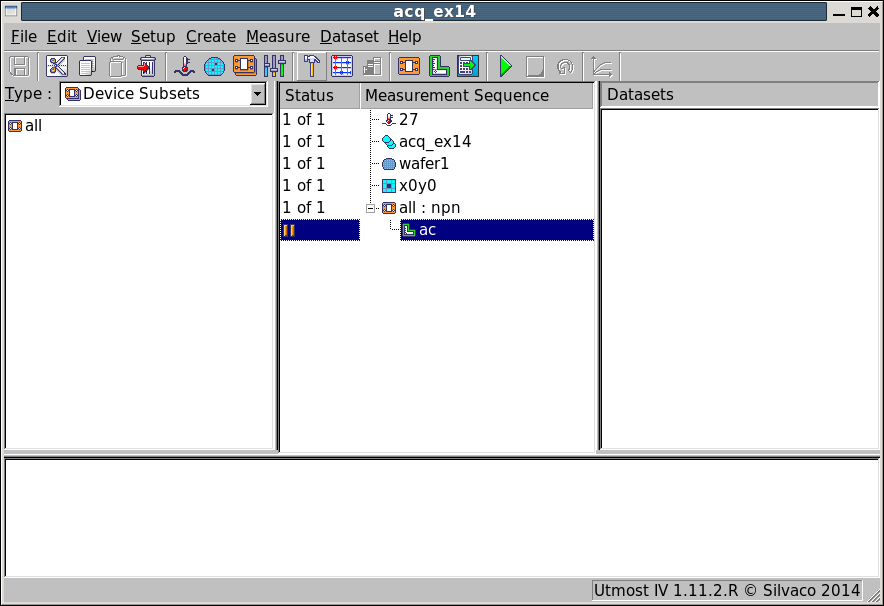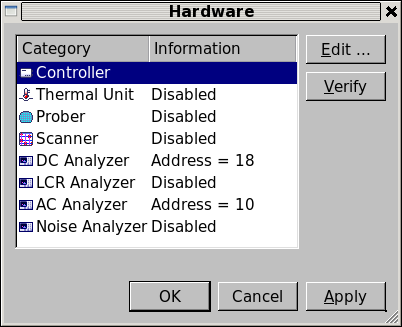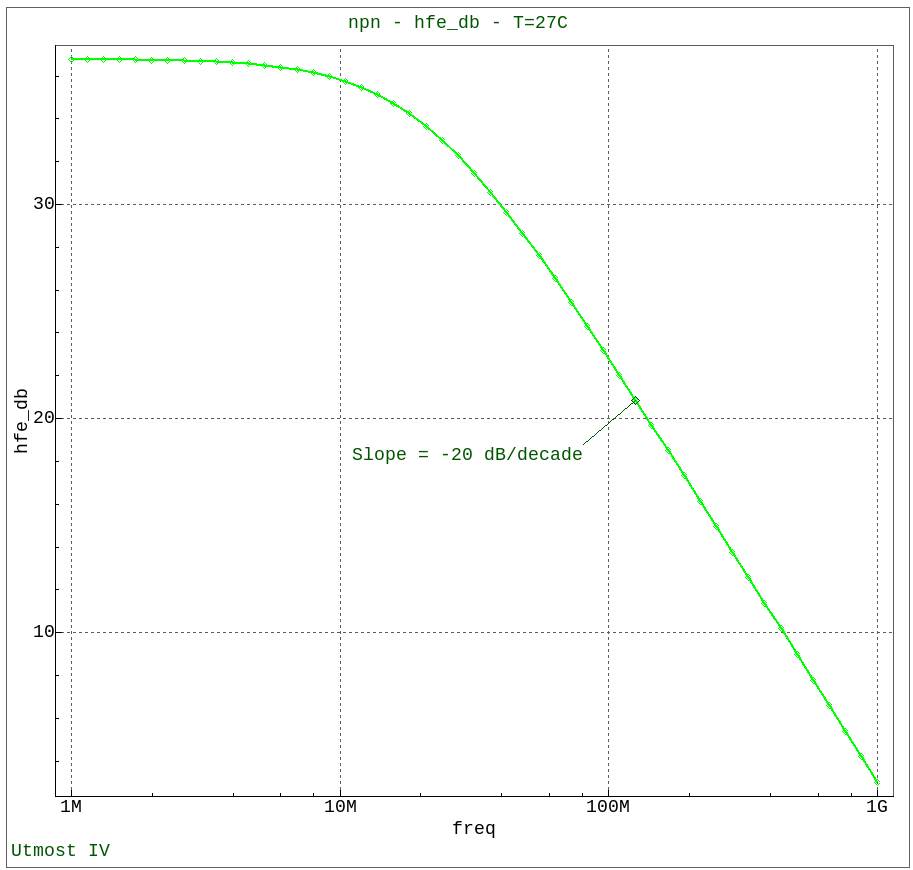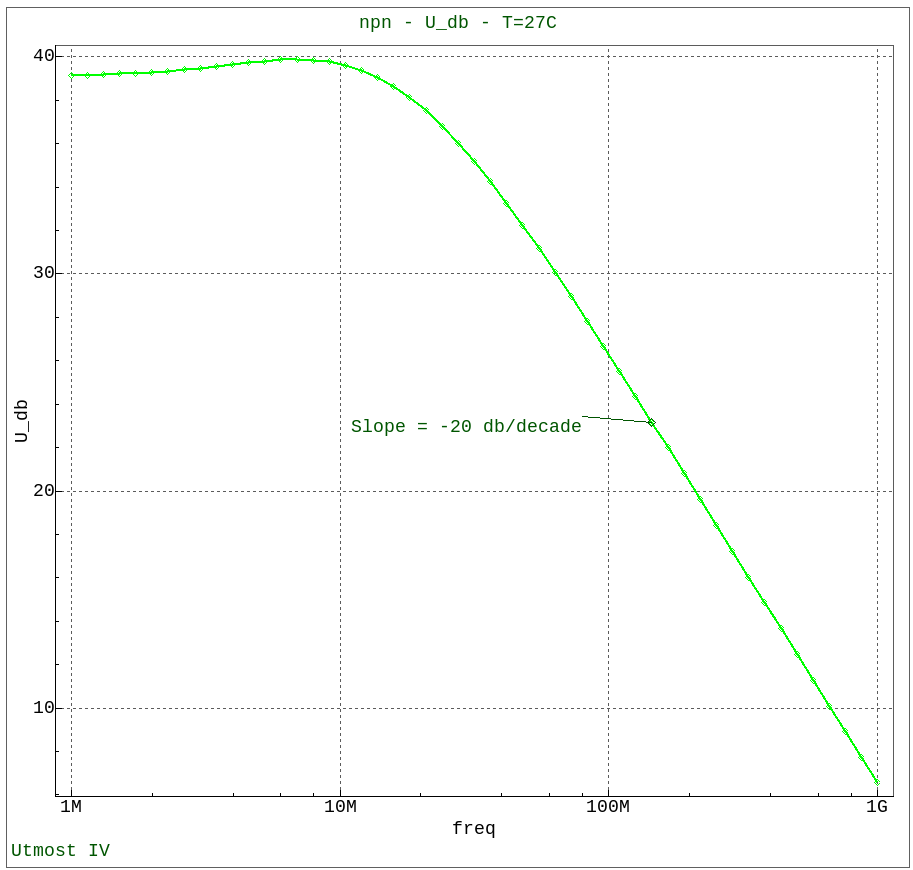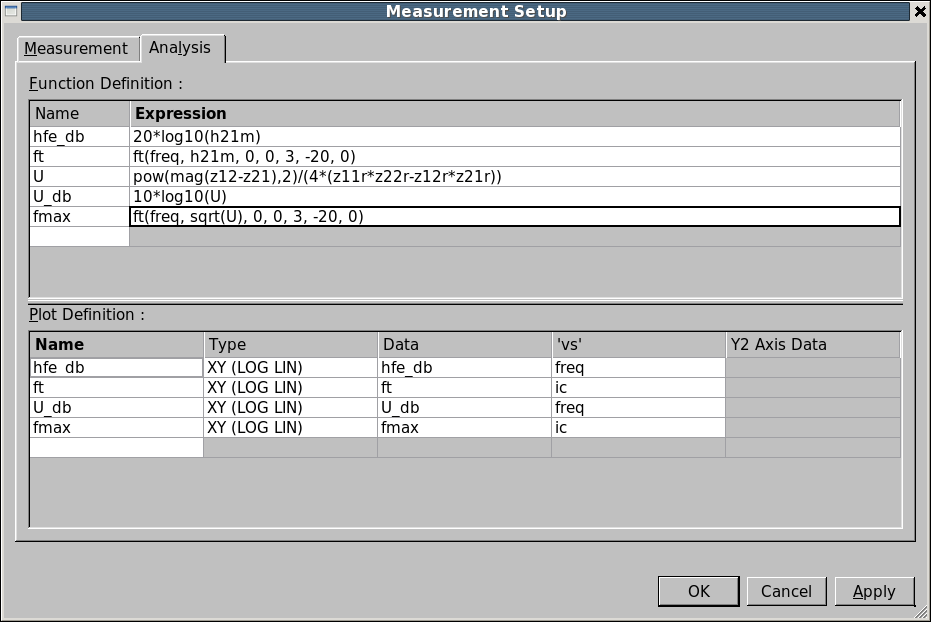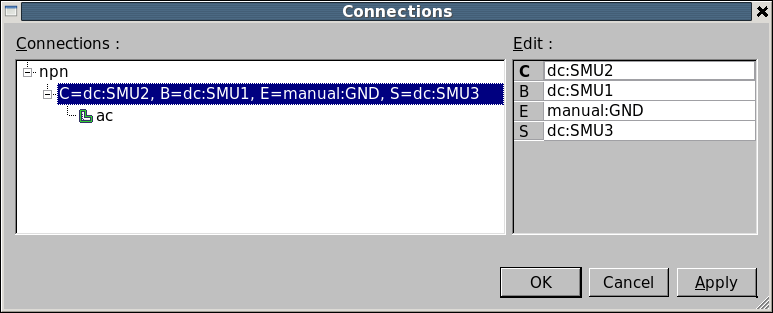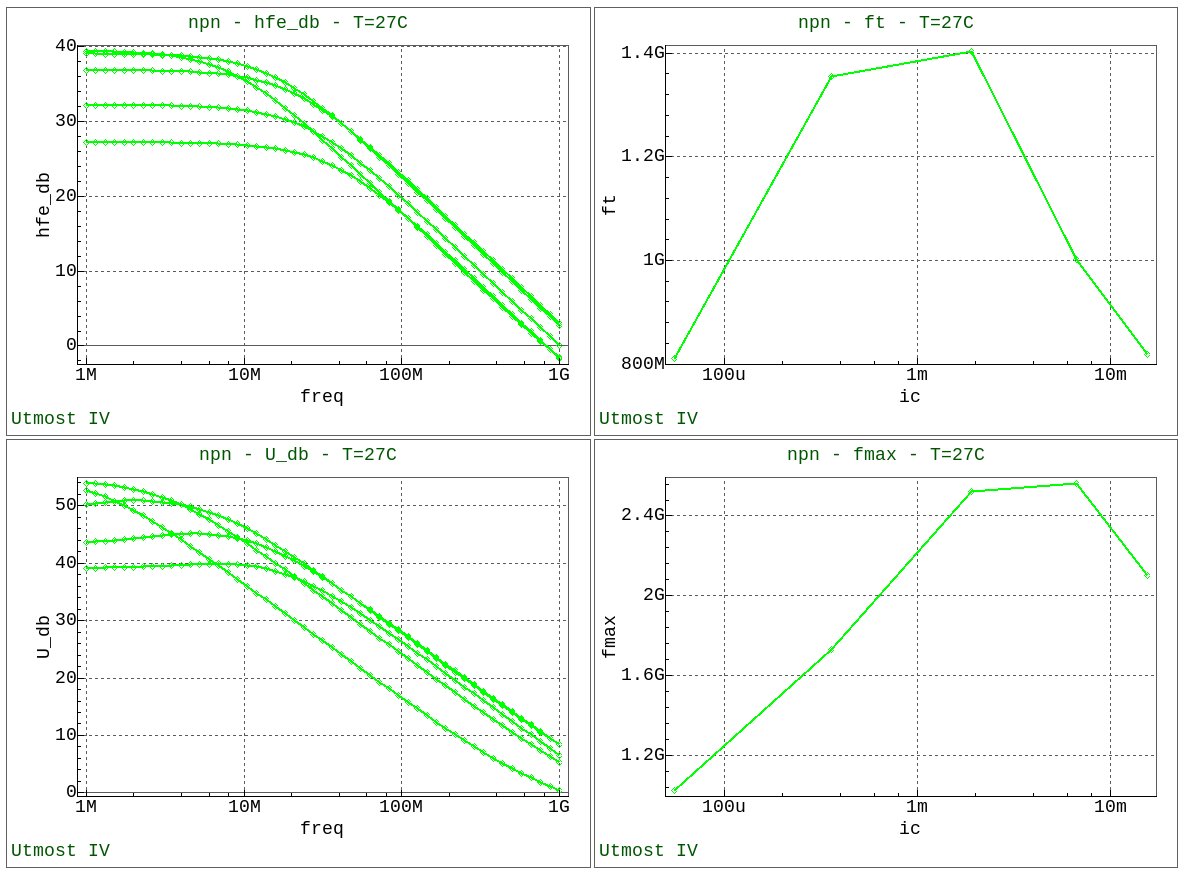acq_ex14 : Bipolar AC Measurement with ft and fmax
Requires: Utmost IV, SmartSpice, SmartView
Minimum Versions: Utmost IV 1.11.2.R, SmartSpice 4.10.6.R, SmartView 2.28.2.R
This example describes how to perform a bipolar AC measurement and then plot the ft and fmax characteristics.
The project file acq_ex14.prj for this example should be loaded into your database. When opened, the project will look as shown in acq_ex14_01.png . In the project hardware, the DC Analyzer and AC Analyzer are enabled for measurement as shown in acq_ex14_02.png .
AC measurements are typically performed using a network analyzer which measures s-parameters at multiple frequencies. The analyzer has two ports which are connected to the bipolar transistor. Port 1 is connected to the base and port 2 is connected to the collector. The emitter of the transistor is connected to the common ground of the two ports. During the AC measurement, the s-parameters or scatter parameters will be measured between these two ports. These s-parameters are complex values, having both real and imaginary parts. For a two port measurement, there will be four s-parameters which are commonly known as s11, s12, s21 and s22.
Once you have the s-parameters of your two port system, you can convert these into other more useful forms, such as impedances, admittances and gains. All of these impedances, admittances and gains are also complex values. This is all automatically done for you by Utmost IV. In addition, Utmost IV also provides useful shortcuts for specifying the magnitude, phase, real and imaginary parts of these complex numbers.
The project contains a single AC measurement setup which is defined as shown in acq_ex14_03.png . For all AC measurements, the frequencies at which the s-parameters will be measured are defined by the first sweep in the measurement setup. The measurement setup also defines one or more DC bias points at which the frequency dependent s-parameters will be measured. In this example, the collector voltage is fixed at 2 volts, while the base voltage is swept from 0.7 to 0.9 volts in 50mV steps. At each one of these DC bias points, the s-parameters will be measured across the frequency range.
The exact frequency and bias range you need to use will be determined by the device being measured and also by the limitations of your test equipment.
Unity Gain Bandwidth, ft
The unity gain bandwidth (ft) is defined as the frequency at which the forward small signal current gain (hfe) of the transistor has a magnitude of 1. A magnitude of 1 is equivalent to zero dB.
h21 = i2/i1 = ic/ib = hfe = forward current gain
h21m = magnitude of h21
20 * log10 (h21m) = magnitude of h21 in dB
If you plot the magnitude of h21 in dB vs frequency on a log scale, you will get a plot which looks like acq_ex14_04.png . At low frequency the gain of the bipolar transistor is constant. Once you reach a certain frequency, the gain will reduce with a single pole roll off. The slope of this reduction in gain will be -20dB/decade of frequency. The frequency at which the gain is reduced to 0dB is the unity gain bandwidth or ft for this specific DC bias point.
Utmost IV provides a special function which will extract the ft characteristic for each DC bias point.
ft = ft (freq, h21m, 0, 0, 3, -20, 0)
The value of ft can then be plotted vs the DC bias conditions.
Maximum Oscillation Frequency, fmax
This is defined as the frequency at which the forward small signal power gain of the transistor has a magnitude of 1. A magnitude of 1 is equivalent to zero dB.
The power gain of this two port system is best described using Mason's invarient unilateral power gain, U. [1][2]
U = pow(mag(z12-z21),2)/(4*(z11r*z22r-z12r*z21r))
10 * log10 (mag (U)) = magnitude of U in dB
If you plot the magnitude of U in dB vs frequency on a log scale, you will get a plot which looks like acq_ex14_05.png . At low frequency the gain of the bipolar transistor is relatively constant. Once you reach a certain frequency, the gain will reduce with a single pole roll off. The slope of this reduction in gain will be -20dB/decade of frequency. The frequency at which the power gain is reduced to 0dB is the maximum oscillation frequency or fmax for this specific DC bias point.
We can make use of the special ft function to extract fmax as well by remembering the following.
10 * log 10 (x) = 20 * log10 (sqrt (x))
fmax = ft (freq, sqrt (U), 0, 0, 3, -20, 0)
The value of fmax can then be plotted vs the DC bias conditions.
The analysis section of the measurement setup includes the function and plot definitions to display the characteristic gain vs frequeny plots and also the ft and fmax vs DC bias condition plots as shown in acq_ex14_06.png .
You must also define the DC instrument source connections. The measurement connections are shown in acq_ex14_07.png . In this example, DC SMU1 is connected to Port 1 and to the base of the bipolar, DC SMU2 is connected to Port 2 and to the collector of the bipolar. The emitter is connected to the AC ground of the network analyzer. In this case, we set the connection for this terminal to 'manual ground'. Finally the substrate of the transistor is biased using DC SMU3.
Before measuring the bipolar transistor it is essential that you calibrate the AC network analyzer instrument and perform de-embedding on the test structures that you have available. To begin the calibration and de-embedding process, select Measure->Calibrate from the project menu. Once calibration is done, AC measurement will be performed by selecting Measure->Run from the project menu.
For this example, we can now switch the project into its simulation mode by selecting Measure->Simulation from the project menu. This will allow us to view the typical characteristics which will be generated when the measurement is performed.
When the measurement sequence is run, the measured data will be automatically stored in the database and the measured results will be shown in the dataset selector area of the acquisition project as shown in acq_ex14_08.png .
These four plots show how the transistor small signal forward current and power gain vary with frequency and DC bias conditions. The ft and fmax figures of merit are also calculated and plotted. In this simulation example, the peak ft value is around 1.4 GHz and the peak fmax value is around 2.5 GHz.
References:
[1] Mason, Samuel (June 1954). "Power Gain in Feedback Amplifiers" IRE Transactions on Circuit Theory, Vol 1, no 2
[2] Gupta, Madhu (May 1992). "Power Gain in Feedback Amplifiers, a Classic Revisited" IEEE Transactions on Microwave Theory and Techniques, Vol 40, no 5


